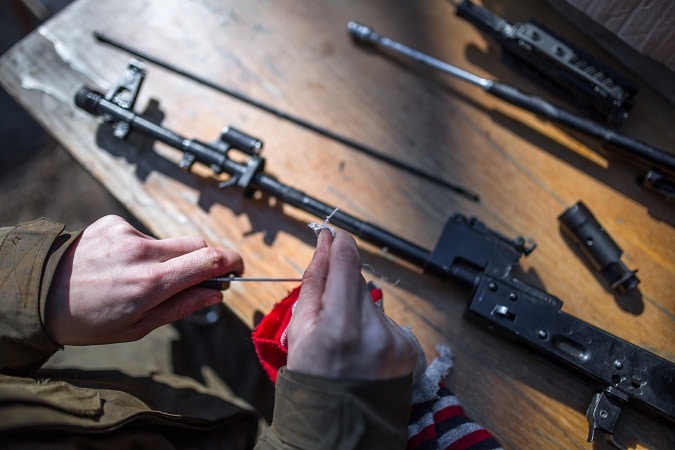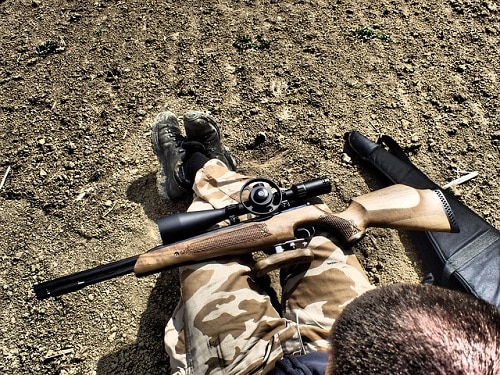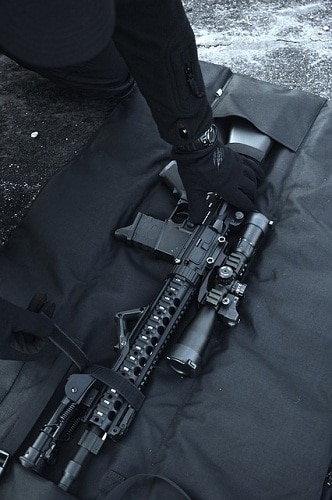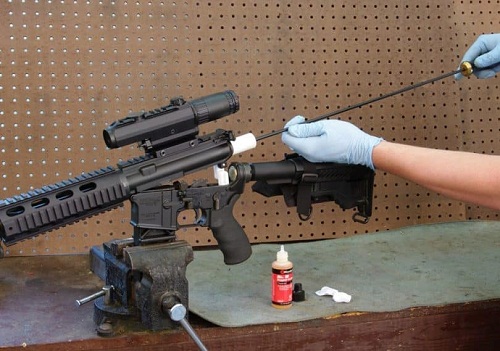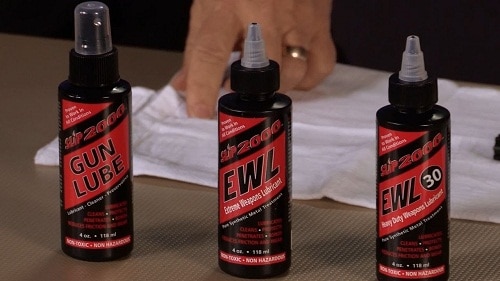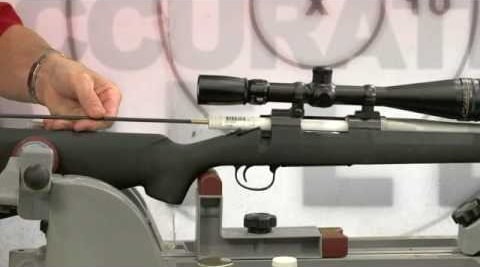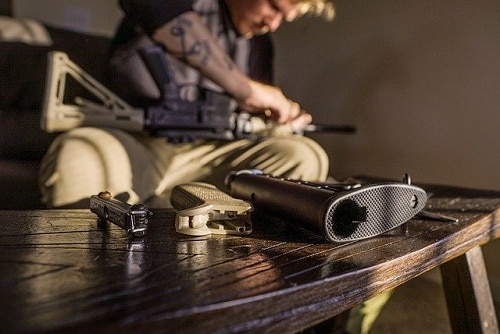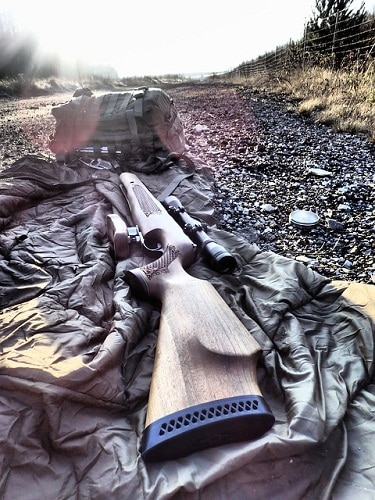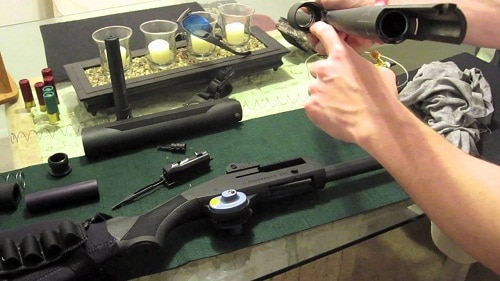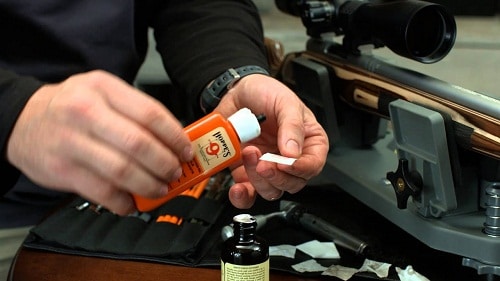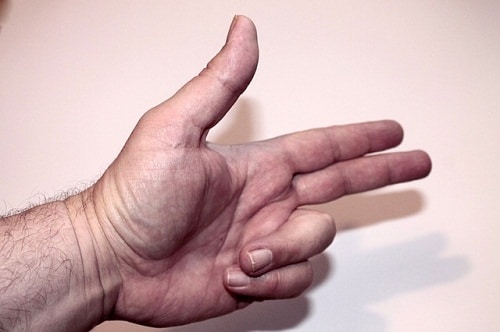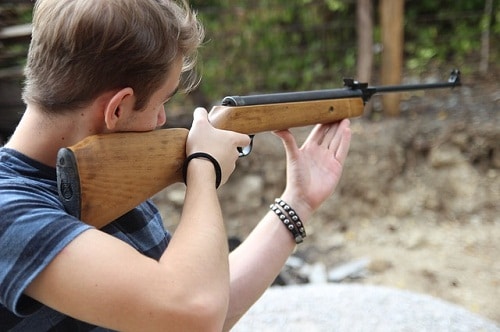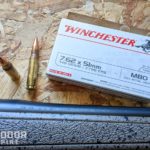Everybody knows that you should clean your gun.
However, it seems that no two people can agree on how or how often to do it!
There are a lot of different philosophies about when and how to clean your rifle.
A well-maintained firearm will perform in many environments and will resist rust and other forms of corrosion.
A poorly maintained firearm can be subject to minor or even catastrophic failures.
Ultimately, how and when you clean your guns is up to you. Here’s all the information you need to keep your guns clean without wasting oil and solvent.
Do You Even Need to Clean Your Rifle?
Back in ye olden days, guns used black powder, which starts corroding metal almost immediately after you fire the shot.
You’d have to clean your gun after half a dozen shots because of all the fouling and lead buildup!
The switch to smokeless powders made things easier, but corrosive gunpowder was cheaper than noncorrosive powder, so many militaries produced billions of rounds of ammo filled with corrosive ammo.
If you’re using modern production ammo, then chances are high that it’s noncorrosive.
However, even the cleanest-burning smokeless powder still causes some amount of fouling. Unburnt carbon (that black soot) will build up in your firearm’s action, eventually gumming up the works.
Copper jackets keep lead from fouling your gun’s bore, but copper will build up over time and affect accuracy.
Oil will eventually burn off or evaporate, leaving your gun unlubricated.
There are guns known for running uncleaned so long as you keep them wet with lubricant, but it’s still a good idea to keep your guns clean to minimize the risk of stoppages.
When to Clean Your Rifle?
Your first clue about when to clean your rifle is to check out the owner’s manual.
The typical advice is to clean your gun after every time you shoot it and to clean the gun before you put it away for long-term storage.
Some firearms, such as AR-15s, AKs, and Glocks are designed so you don’t have to meticulously keep them clean. Keep them lubricated, and you can go a long time between cleanings.
Generally, I clean my nicer firearms (such as precision bolt-action rifles and trap shotguns) after every range trip. I give my modern sporting rifles and striker-fired pistols a quick bore snake and call it good until they get really dirty.
You do want your guns squeaky clean and well oiled before you put them in storage, though, regardless of the type!
Necessary Equipment
Gun cleaning requires a few different tools.
You’ll need a solvent, a lubricant, a protectant, a way to clean your gun’s bore, and a way to clean the rest of the gun.
Some gloves are a good idea as well because many solvents are not skin friendly.
Some people also include more advanced tools such as a gun vise, a bore guide, and a bore light.
Several companies make cleaning kits for different types of firearms that have the basics of what you’ll need.
The Difference Between Solvents, Lubricants, and CLP
Cleaning your gun includes applying liquids to clean, lubricate, and protect your gun.
Solvents accomplish the cleaning portion. Cheap solvents aren’t terribly effective. Use a good gun solvent such as Hoppes No. 9.
Lubricants are oils and greases that reduce friction. These keep your gun’s metal parts from seizing.
Protectants stop your gun from rusting and make it easier to clean. Your lubricant will cover this function, but waxing guns is another way to do it..
CLPs are products that combine a solvent with a lubricating and protecting oil. These products work well enough, though some people argue that they’re not as good as dedicated products.
Break Free CLP and SLIP2000 EWL are examples of CLPs. I’m a big fan of SLIP2000 EWL and have found it to be an excellent all-around product for field cleanings.
Oils and Greases
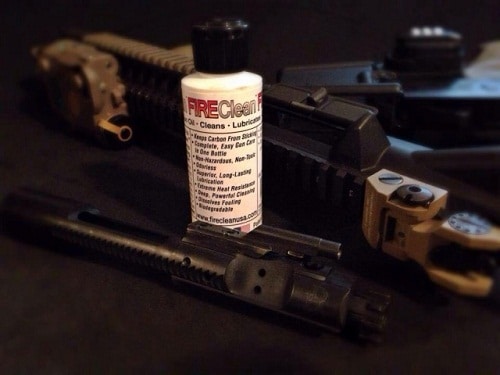
Both oil and grease can be used to lubricate your firearm.
There’s no hard difference between the two. Generally, gun oil runs at room temperature, and gun grease stays where you put it.
It’s sometimes recommended to use grease where firearm components slide along each other and oil where components rotate or where you need the oil to wick itself into small areas.
I’ve had good success just using oil.
Bore Cleaning Tools
You’ll need some way to clean out the bore.
The classic method is to use a cleaning rod with interchangeable tips. This lets you use brushes and cleaning patches.
If you’re going to use a cleaning rod, then get a polymer, carbon-fiber, or soft-metal cleaning rod. Steel cleaning rods can scratch your bore and ding your crown, hurting accuracy!
A bore guide can aid in using a cleaning rod without letting it damage your bore.
The other big alternative is a bore snake. Bore snakes are long lengths of fabric with built-in brushes that scrub and wipe your bore in just a pass or two.
I prefer bore snakes for quick wipe-downs and field cleaning. I leave the cleaning rod at home for deep cleaning.
Note that you should never use a steel brush in your bore! In fact, I recommend you avoid using a steel brush on any part of your gun.
Other Tools
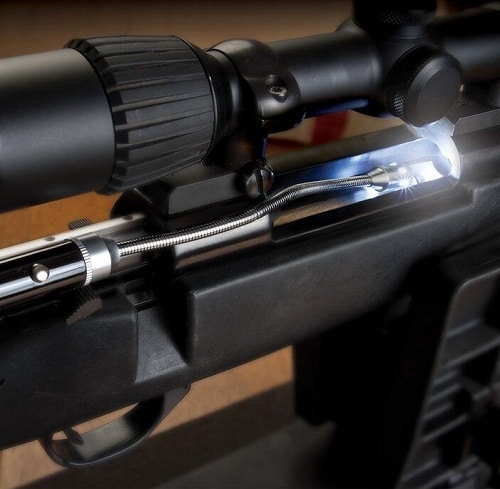
You’ll also need some brass or nylon brushes to scrub the non-bore parts of your gun, such as inside the receiver. Toothbrushes can work as well.
A gun vise can hold your gun in position as you clean it. I’ve never needed one, but many people love them.
Bore lights allow you to see inside the bore to see if the rifling is adequately clean. Looking through the barrel with a light on the other end doesn’t suffice because most lights are bright enough to wash out small amounts of copper fouling.
Plastic dental picks are great for scratching out carbon deposits without damaging the underlying metal. There are also dedicated carbon scrapers that do a better job.
Chamber brushes are good for keeping tighter chambers clean or for cleaning your chamber for when you shoot steel cased ammo then brass cased ammo.
Cleaning Methods
There are three basic cleaning methods:
- The Quick Wipe Down
- Field Cleaning
- Deep Cleaning
Each one gets more and more in-depth and also takes more equipment and time.
However, before you clean your rifle, ensure it’s unloaded.
Think it’s unloaded? Think again!
Remove any magazine, cycle the action, look into the chamber, and stick a finger into the chamber. Make absolutely sure the firearm is unloaded before you start cleaning it!
The Quick Wipe Down
You can wipe down your gun in moments, making it great for a quick clean at the range before you head home.
All this entails is passing a bore snake through your gun from chamber to crown. Then wipe a rag over any parts of the receiver you can reach without disassembling the gun.
Field Cleaning
Field cleaning is more involved than the quick wipe down but still doesn’t take very long.
Disassemble your gun into its largest components. For example, if you’re cleaning an AR-15, then you want to separate the receivers and remove the bolt carrier group. If you’re cleaning a Glock, then take the slide off the frame and remove the recoil spring assembly and the barrel.
Apply solvent to your bore brush and scrub it from chamber to crown. Don’t insert the cleaning rod from the muzzle end!
Then, put the jag onto your cleaning rod and push cleaning patches through the barrel. Use a new patch each time until it comes out without any discoloration.
Feel free to cut the patches down to fit your bore.
Then, use either a bore mop or a patch with oil and push that through your barrel.
If you’re using a bore brush then start with solvent them move on to oil.
Next, it’s time to give the rest of the gun a quick clean.
Scrub the various components with a brush or rag soaked in solvent then follow it up with a light coat of oil.
You don’t want your metal parts to be sopping wet with oil. Follow your gun’s manual for how much oil to use. Most of the time, all you want is a very light coat. Any more will attract dust and grime.
Reassemble your gun, and you’re good to go!
Note that, for field cleaning especially, you can combine the solvent and lubricant steps with a single CLP-style product.
Deep Cleaning
When deep cleaning, you want to disassemble your gun to the extent that won’t violate any warranty.
With that AR-15, you’ll want to take the firing pin and bolt out of the BCG. For the Glock, push out the pins holding the trigger and trigger housing.
Also, make sure to get a solvent that can clean copper residue!
The actual steps are the same as with field cleaning. Use solvent until a clean patch doesn’t pick up any fouling. Then, make sure all of the metal components have a good lubricant and protectant.
The main difference is that now you’ll take advantage of the copper solvent to make sure your bore is as perfect as possible, you’ll use a carbon scraper to get all of the carbon buildup off, and you’ll clean all of the parts of the gun you can, not just the major components.
Give the solvent time to work. Fifteen minutes should be good. Small parts can be soaked in solvent.
Spray solvents can be good for cleaning fire control group components. Then apply an oil that will use capillary action to draw itself into the now-dry crevices.
Gun Cleaning Tips
1. WD-40 is not a lubricant; it evaporates!
2. A magnetic tray can help you keep track of small parts.
3. Brass wool will not harm your gun’s finish and can be used to remove rust when combined with oil.
4. Some gun products can damage wood or polymer furniture, so it may be a good idea to remove grips and stocks when deep cleaning.
5. Use the right size cleaning rod for your gun’s caliber to prevent flexing and binding
6. Scrub with brushes and push patches through once.
7. Feel free to add lubricant between cleaning sessions, but make sure to wipe off any excess.
8. Don’t put your brush into the solvent bottle. That can contaminate your solvent.
9. Different lubricants are better in different environments; for example, Frog Lube is great for warmer locations but can gum up in cold weather.
10. The bore shouldn’t be heavily oiled, so finishing it off with a dry patch is a good idea.
11. Don’t oil your bore if you’re cleaning between strings at the range.
12. Warmth helps most solvents work better.
13. Most gun oils are no more effective than basic motor oil; Mobil-1 is one of the best gun oils for your dollar!
14. Finally, make sure there is no loose ammunition in your work area, because rounds love to teleport inside your gun’s chamber.
Conclusion
Gun cleaning can seem like a complex topic.
However, it’s a simple topic at the core:
Minimize fouling and keep your gun lubricated and protected.
Overcleaning cannot damage your firearm’s metal parts. It can, however, cause you to pour expensive solvents down the drain.
As long as you keep your firearm lubricated (but not dripping wet) and knock down carbon, copper, and lead deposits before they impact your firearm’s function, you’re keeping your gun clean enough.

